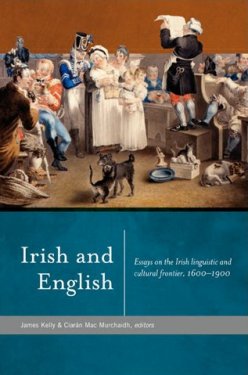Irish and English:
|
|
The transformation of Ireland from a predominantly Irish-speaking country to a primarily English-speaking country was the most profound social change to take place on the island between the seventeenth and the twentieth century. Yet the nature, manner and course of that transformation are less than clear. The object of this collection, is to provide a variety of perspectives on the moving linguistic frontier that obtained in Ireland in order better to understand the multiplicity of reasons for this linguistic shift, and to expand and deepen our appreciation of the manner in which it took place. The collection brings together scholars from a variety of disciplines, in order both to examine established aspects of this important question anew, and to offer new insights and vistas based on the most recent scholarship with the purpose of enhancing our understanding and awareness of the crucial language shift that prompted the displacement of Irish by English. This book can be purchased directly from the publishers. |
Contents'Introduction: establishing the context' Reviews"Vincent Morley's brilliant essay continues the late Breandán Ó Buachalla's work of rebranding one frontiersman, Seathrún Céitinn, as a forward-looking rather than a reactionary or elegaic figure. Morley has identified one hundred and forty-four manuscripts containing copies of Céitinn's Foras Feasa ar Éirinn, but also shows that over time it became more a work of reference than a history to be read from start to finish." Cormac Ó Gráda, Dublin Review of Books, November 2012. "A recurring theme in the collection is the resilience of manuscript culture among the Gaelic Irish. The argument is made most forcefully by Vincent Morley in his chapter where he contests the print-based notion of the public sphere which has the unfortunate consequence of reducing the majority Irish-speaking population to solipsistic eccentrics paddling dolefully in the backwaters of illiteracy. Morley's contention ... is that a thriving manuscript culture provided a crucial infrastructure for the transmission of reworked notions of identity, culture and sovereignty amongst Irish-speaking Catholics." Michael Cronin, Studia Hibernica, 38 (2012). "Another essay which has its origin in an earlier book in Irish is Vincent Morley’s account of how Foras Feasa ar Éirinn was received in Irish historiography. This he does with meticulous precision recounting the number of manuscript editions that were copied or transmitted according to time and place ... His recent Ó Chéitinn go Raiftearaí: mar a cumadh stair na hÉireann (2011) is a brilliant account of Irish historians writing of their own history and of its reception both amongst the literate class and those who could only hear with their ears." Alan Titley, Irish Literary Supplement, Fall 2013, p. 20. "Vincent Morley’s chapter adds to his burgeoning reputation as he traces the influence of Keating’s Foras Feasa ar Éirinn in shaping Irish notions of the past ... Morley advances an argument that Irish literary culture underwent a process of popularisation in the early eighteenth century, involving a decline in interest in learned prose works and an increase in poetry/song which appealed to a wider section of the population." Brian Ó Conchubhair, Irish Economic and Social History, XL (2013). "Vincent Morley’s engaging account of the distribution and popular influence of Foras Feasa ar Éirinn from the seventeenth to the nineteenth century successfully illuminates shifting literary and cultural frontiers. Demonstrating that manuscript circulation of Keating’s text had peaked by 1725, Morley argues that Irish literary culture underwent a process of popularization beginning in the early eighteenth century." Anne Markey, Irish University Review, 44.1 (May 2014). "Contributors include established historians and Irish-language scholars who have specialized in the literature and culture of the time. Accordingly, an important strength of this book is that non-Irish-language readers have access through translation to original quality research first published in Irish, as well as Irish-language scholars' in-depth knowledge of relevant sources in the language." Pádraig Ó Siadhail, The Canadian Journal of Irish Studies, 39.2 (2016). |
